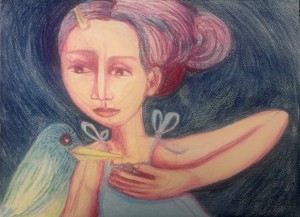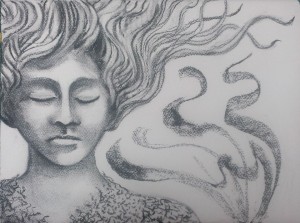On Day 14, Kat drew this:
On day 10, this:
And on Day 3, this:
Day 3 is my favourite. Something about that feather-ish headdress, the Big Top-like shape in the backdrop, and the rings radiating from the figure.
Every day now, for the past two-and-a-bit weeks, my friend Kat—whom I share housed with back in the dark ages, when we were both at university—has been drawing one picture. Whatever comes to mind, whether she thinks it’s good or not. Then she posts it online that day, so there’s no time (in her words) to “put off being out there until I feel brave enough. It helps that it’s daily so I know I can try again the next day … or the next day”. She’s doing this while teaching, raising children, cooking, washing, reminding. Probably walking the dog in there somewhere, too.
Kat’s daily art challenge has got me thinking about three things:
- Creativity
- Eleanor Roosevelt, and
- Halloween.
I almost want to put that first point in inverted commas—creativity is a word I’m quite comfortable with when we’re talking about kids and Clag, but makes me a bit squeamish when applied to Proper Grown-ups. With, like, Houses. And Responsibilities. I mean there are the Serious Novelists, right, or Serious Artists, and no-one goes off laughing at them. Because they’re Serious. But the rest of us, well—if we’re really trying to make art, perhaps we’d rather not let on.
I know Kat feels a bit like this. Coupled with the desire to create is the fear of being told you’re rubbish; the worry that the people you admire will scoff at the things that you made. And these things don’t just come from your pen. They come actually from you: your eyes, your memories, all the things you think about the world and the way it works. Talk about feeling exposed.
Which brings me to Eleanor. I’ve just finished reading a wonderful biography of Eleanor Roosevelt and her husband, Franklin D. Roosevelt (who was the 32nd President of the United States). Biographies are great because they epitomise hindsight—we usually know how things are going to turn out, that the struggle will be worth it, the battle won. So when I read about Eleanor’s mother mocking her (she used to call her ‘Granny’, because she looked so serious), or the fact that both Eleanor’s parents were dead before she’d turned ten, I could see it as part of a broader success story. Because Eleanor grew up not just to be America’s First Lady, but a real force in American politics: she was highly influential in the U.S. Democratic party, and as a U.S. delegate to the United Nations was a driving force behind the Universal Declaration of Human Rights. The biography charts her course through a slew of difficulties: the heartbreak of discovering her husband’s affair; the judgement she bore for her appearance (apparently she didn’t inherit her mother’s good looks); and FDR’s struggle with polio, which meant that he would never walk unaided again.
But I wonder what would happen if, as we read about other lives, we were able to stay suspended in each moment? Because when Eleanor Roosevelt was standing in that doorway, sucking her fingers and being called “Granny”, she didn’t know how it would all turn out. Nor could she see the future, when she watched her husband in the grip of a raging fever, unable to move his legs. Life is a series of moments in which we don’t yet know the outcome.
Which brings me to Halloween.
Now I know there has been a bit of debate in Australia, about whether Halloween is just an over commercialised ‘American import’ that has no place in the Southern Hemisphere. After all, October 31 is spring in Australia, and it’s daylight savings. But we also celebrate Christmas in summer, and Easter in autumn. Besides, it’s not only an American festival—and it’s great fun.
I first experienced Halloween in the U.S. several years ago. We walked a block from our apartment and the darkening streets were full of people—kids dressed up as pirates and teddy bears, adults in rainbow clown wigs, teenagers wearing mustard bottle and ghoul costumes. My neighbours had draped fake cobwebs over fences; put jack-o’-lanterns on front porches; some had gone all-out on the decorations, and were inviting the neighbourhood in to their ‘haunted house’. People where either on the street shepherding children with candy receptacles, or answering doors and handing out sugar (one hold-out was distributing raisins).
This year, we did Halloween closer to home. We found at least 10 decorated houses (etiquette states that you only knock if the house is decorated) and the group of kids I was with brought in a decent candy haul. We knocked on strangers’ doors; they smiled and wished us a good night. Sure, the sugar was nice, but the welcome was lovely. It was a neighbourly enactment of ‘opportunity knocking’.
Which brings me back to Kat’s daily art challenge. To make anything new—to be creative—we have to be able to try our best, while also suspending judgement. Kat’s actually found that some of her ‘failures’ (that would have otherwise ended up in a drawer) are the ones people identify with most. But you only find that sort of thing out, if you get out there. There’s no way of knowing whether the story will end with a fizzle, or success. Which can be pretty unpleasant, especially in the dead of night when you’re wondering if everyone knows you’re a total fraud who has no right to even hold a pencil, let alone create anything.
But the story’s not written yet. We can keep working harder, push ourselves, enjoy making stuff. And then, when we’re ready, make our way out the door and into the street. If we’re lucky, we’ll meet some friendly faces. But whatever the outcome, the first step will sound something like this:
Knock, knock.


